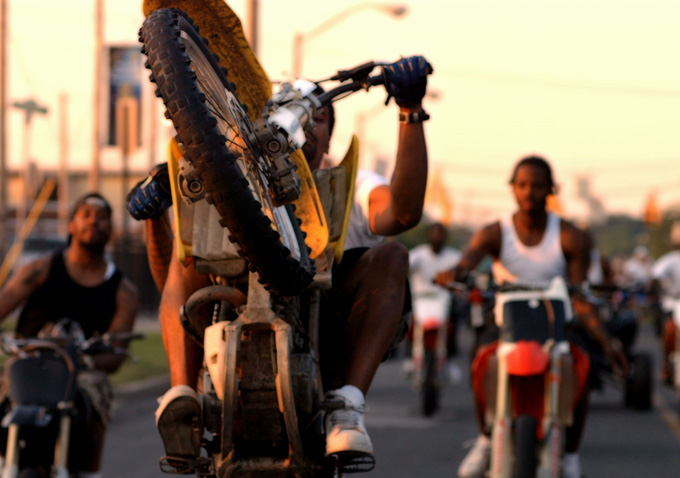
This first film from Lotfy Nathan benefits from a pair of engaging subjects: teenage Pug and the city of Baltimore. In “12 O’Clock Boys,” Nathan captured Pug’s life for three years, following him as he moved from childhood to adolescence across several rough Baltimore neighborhoods. His mother describes him as wild, and she’s unable to keep him from chasing after the 12 O’Clock Boys, a group of dirt bike riders. The group is so named for their jaw-dropping feats of coaxing their bikes up onto one wheel into a vertical position, like the hands of a clock at noon. Not discluding his desire to join the riders, Pug is a handful, but what makes him such a challenge for his mother Coco, makes for fascinating viewing for the audience. He’s full of the energy of a defiant child and the bravado of someone beyond his years who hasn’t yet realized his mortality. He first has a miniature four wheeler, followed by his own bike, and he practices tricks so he can join the group on their Sunday rides across the city.

In ways that won’t be surprising to fans of “The Wire,” Baltimore is a character as well. We see a variety of neighborhoods as the riders course through the town, as the cops don’t actively chase them out of concern for citizens who might be caught between the riders and the police. The result is that each Sunday, around 100 members speed through the city without concern for the others on the road or the sidewalk. While the city as a whole may see the men as a menace, some of those in the community feel that joining the 12 O’Clock Boys is a positive alternative to other criminal pursuits.
While the film briefly zooms out to show other experiences of those in the city, this is Pug’s movie. His interactions with his mother, his bike, the world around him and the director himself are fascinating, particularly the way he matures across three years. Nathan picked the perfect subject at the perfect time in his life: a sympathetic, charismatic kid whose future is uncertain. After the death of one of his few male role models (who helped expose him to the exploits of the 12 O’Clock Boys via video and YouTube), Pug tries to become a member. Joining the group seems to be the driving force in his life, keeping him from pursuits that are perhaps more dangerous and ill-fated, but the documentary shares a few stories that demonstrate that the dirt bikers aren’t immortal.

“12 O’Clock Boys” is a bit too enamored of slow motion—despite how appropriate the technique is for the subject matter—and how gorgeous it looks, especially when set against the synthy soundtrack. The riders hang in the 12:00 position as time seems to stop throughout the film, and then it genuinely does slow down. But what works in small doses to establish the feeling that the 12 O’Clock Boys are beating both gravity and the clock ultimately is used at Zack Snyder levels of frequency. The film barely hits the 75-minute mark, and one wonders if it would have fallen below an hour if the film moved at normal speeds. The documentary’s subject is serious—though entertaining—but it still feels slight at times. Some threads (such as that of a former cop blamed for killing a rider) aren’t fully developed, and they feel like they’re included as padding in their nascent state.
Brief as it may be, “12 O’Clock Boys” is an exciting, beautifully shot look at a subculture through the eyes of one of its most devoted admirers. It’s a measured approach that neither wholly endorses or condemns the antics of its title group of bikers, while allowing the audience to see what they do through Pug’s own eyes. [B]

